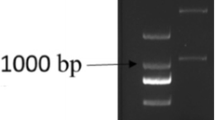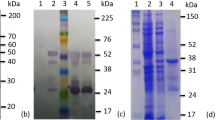Abstract
Pathogenicity test ofFusarium oxysporum on ten cultivars of soybean revealed Soymax and Punjab-1 to be most resistant while JS-2 and UPSM-19 were most susceptible. Antigens were prepared from the roots of all the ten varieties of soybean and the mycelium ofF. oxysporum. Polyclonal antisera were raised against the mycelial suspension ofF. oxysporum and the root antigen of the susceptible cultivar UPSM-19. Cross reactive antigens shared by the host and the pathogen were detected first by immunodiffusion. The immunoglobulin fraction of the antiserum was purified by ammonium sulfate precipitation and DEAE-Sephadex column chromatography. The immunoglobulin fractions were used for detection of cross-reactive antigens by enzyme-linked immunosorbent assay. In enzyme-linked immunosorbent assay, antigens of susceptible cultivars showed higher absorbance values when tested against the purified anti-F. oxysporum antiserum. Antiserum produced against UPSM-19 showed cross-reactivity with the antigens of other cultivars. Indirect staining of antibodies using fluorescein isothiocyanate indicated that in cross-sections of roots of susceptible cultivar (UPSM-19) cross-reactive antigens were concentrated around xylem elements, endodermis and epidermal cells, while in the resistant variety, fluorescence was concentrated mainly around epidermal cells and distributed in the cortical tissues. CRAs were also present in microconidia, macroconidia and chlamydospores of the fungus.
Similar content being viewed by others
References
Abd-El-Rahim M.A., Abou-Taleb E.M., Tohamy A.: Lectins specificity to pathogenesis ofFusarium oxysporum f.sp.vasinfectum.J. Phytopathol.121, 1–7 (1988).
Abd-El-Rahim M.A., Ibrahim I.A., Michail S.H., Fadel F.M.: Serological and immunoelectrophoretical studies on resistant and susceptible watermelon varieties toFusarium semitectumBerk. andRav.Phytopath. Z.71, 49–55 (1971).
Alba A.P.C., Devay J.E.: Detection of cross reactive antigens betweenPhytophthora infestans(Mont.) de Barry andSolanum species by indirect enzyme linked immunosorbent assay.Phytopathol. Z.112, 97–104 (1985).
Chakraborty B.N., Basu P., Das R., Saha A., Chakraborty U.: Detection of cross reactive antigens betweenPestalotiopsis theae and tea leaves and their cellular location.Ann. Appl. Biol.127, 11–21 (1995).
Chakraborty B.N., Purkayastha R.P.: Serological relationship betweenMacrophomina phaseolina and soybean cultivars.Physiol. Plant Pathol.23, 197–205 (1983).
Chakraborty B.N., Purkayastha R.P.: Alteration in glyceollin synthesis and antigenic patterns after chemical induction of resistance in soybean toMacrophomina phaseolina.Can. J. Microbiol.33, 835–840 (1987).
Chakraborty B.N., Saha A.: Detection and cellular location of cross reactive antigens shared byCamellia sinensis andBipolaris carbonum.Physiol. Mol. Plant Pathol.44, 403–416 (1994).
Charudattan R., Devay J.E.: Common antigens among varieties ofGossypium hirsutum and isolates ofFusarium andVerticillium species.Phytopathology62, 230–234 (1972).
Clausen J.: Immunochemical techniques for the identification and estimation of macromolecules, Vol. 1, Part 3, of the seriesLaboratory Techniques in Biochemistry and Molecular Biology (R.H. Burdon, P.H. VanKnippenberg, Eds). Elsevier Publ., Oxford 1988.
Devay J.E., Wakeman R.J., Kavanagh J.A., Charudattan R.: The tissue and cellular location of major cross reactive antigen shared by cotton and soil borne fungal parasites.Physiol. Plant Pathol.18, 59–66 (1981).
Devay J.E., Wilson U.E., Wakeman R.J., Kavanagh J.A.: Occurrence of common antigenic determinants between potato andPhytophthora infestans in relation to host parasite compatibility, inProc. Internat. Symp. Phytophthora: Its Biology, Ecology and Pathology, 43. Department of Plant Pathology, University of California, Riverside 1981.
Fedotova T.I.: Potential varietal resistance to diseases, p. 61 inProc. 7th Internat. Congr. Plant Protection, Paris 1970.
Guseva N.N.: Selection of wilt resistant cotton varieties as influences with the protein compatibility, pp. 111–112 inProc. 7th Internat. Congr. Plant Protection, Paris 1970.
Holtz B.A., Karu A.E., Weinhold A.R.: Enzyme linked immunosorbent assay for detection ofThielaviopsis basicola.Phytopathology84, 977–983 (1994).
Kitagawa T., Sakamoto Y., Furumi K., Ogura H.: Novel enzyme immunoassays for specific detection ofFusarium oxysporum f.sp.cucumerinum and for general detection of variousFusarium species.Phytopathology79, 162–165 (1989).
Koenig R., Paul H.L.: Variants of ELISA in plant virus diagnosis.J. Virol. Methods5, 113–125 (1982).
Linfield C.A.: A rapid serological test for detectingFusarium oxysporum f.sp.narcissi inNarcissus.Ann. Appl. Biol.123, 685–693 (1993).
Lyons N.F., White J.G.: Detection ofPythium violae andPythium sulcatum in carrots with cavity spots using competition ELISA.Ann. Appl. Biol.120, 235–244 (1992).
Mohan S.B.: Cross reactivity of antiserum raised againstPhytophthora species and its evaluation as a genus detecting antiserum.Plant Pathol.38, 352–363 (1989).
Ouchterlony O.: Immunodiffusion and immunoelectrophoresis, inHandbook of Experimental Immunology (D.M. Weir, Ed.). Blackwell Sci. Publ., Oxford-Edinburgh 1967.
Palmerley R.A., Callow J.A.: Common antigens in extracts ofPhytophthora infestans and potatoes.Physiol. Plant Pathol.12, 241–248 (1978).
Purkayastha R.P., Ghosal A.: Immunoserological studies on root rot disease of groundnut (Arachis hypogea L.).Can. J. Microbiol.33, 647–651 (1987).
Purkayastha R.P., Menon U., Chakraborty B.N.:Rhizobium-Macrophomina interaction affecting phytoalexin production and disease resistance of soybean.Ind. J. Exp. Biol.19, 462–465 (1981).
Author information
Authors and Affiliations
Rights and permissions
About this article
Cite this article
Chakraborty, B.N., Sarkar, B. & Chakraborty, U. Detection of cross-reactive antigens shared byFusarium oxysporum andGlycine max by indirect ELISA and their cellular location in root tissues. Folia Microbiol 42, 607–612 (1997). https://doi.org/10.1007/BF02815474
Received:
Revised:
Issue Date:
DOI: https://doi.org/10.1007/BF02815474




